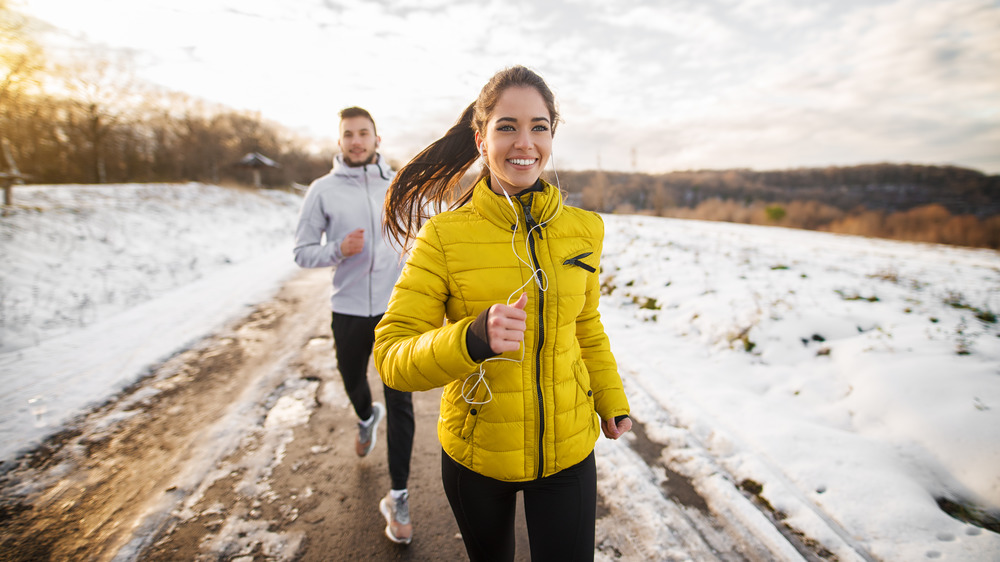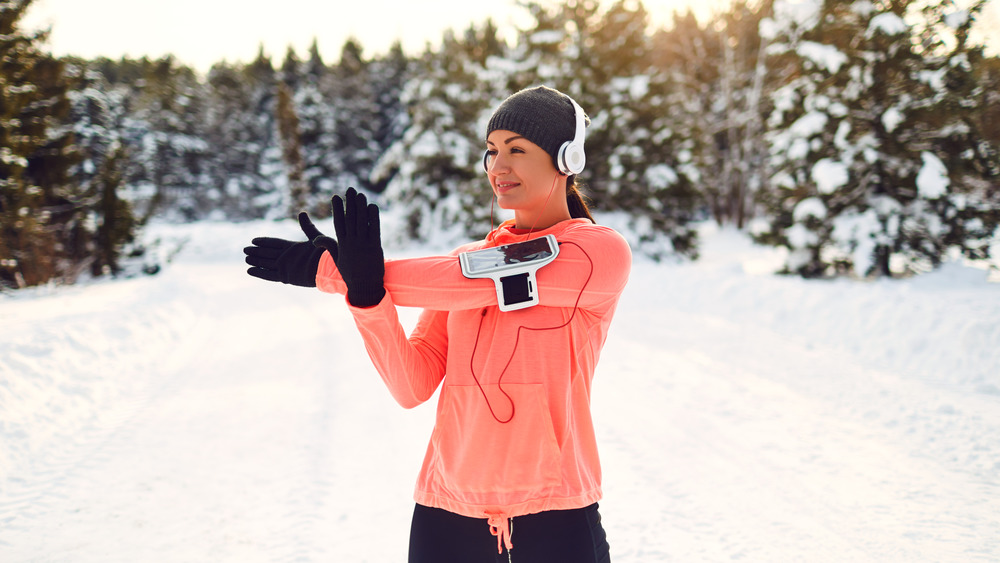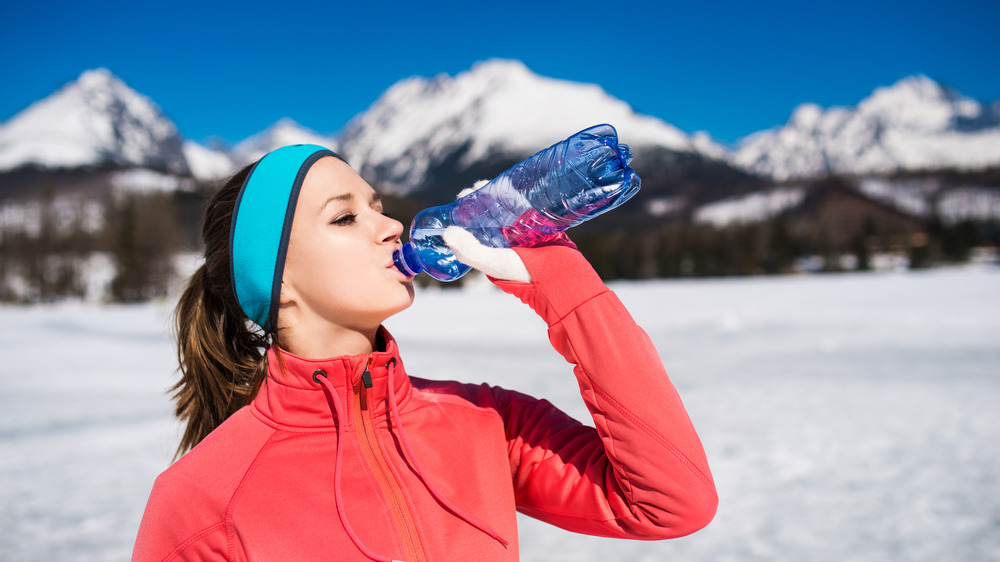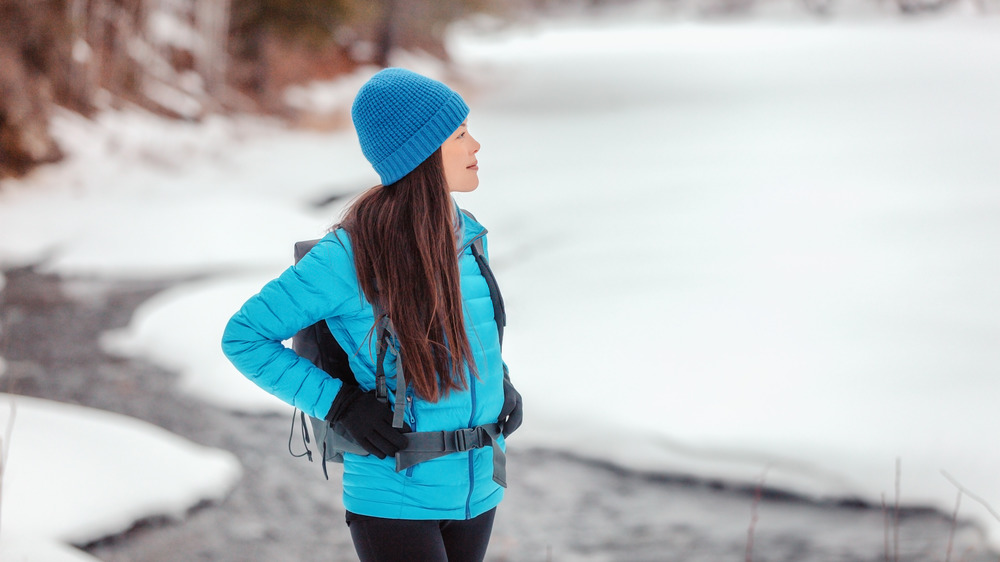What Really Happens To Your Body When You Exercise Outside In The Cold
With the holidays behind us and only the seemingly endless months of a cold winter ahead, it's easy to let fitness routines and goals fall by the wayside. Add social distancing protocols that have forced most of us out of the gyms and into the great outdoors, and you've got the perfect excuse to pound some potato chips instead of pounding the pavement.
And while streaming an episode of Bridgerton while snuggled under a warm blanket sounds a whole lot more appealing than doing burpees in a below-freezing garage, it's not exactly beneficial to your physical or mental health.
We spoke with Dr. Scott Smith, a Board Certified Orthopedic Surgeon at Texas Orthopedics in Austin, Texas, and he gave us the ins, outs, and in-betweens about what happens to your body when you exercise in the cold. And with his expert advice, you can, as he explains, "with some preparation and planning," not only "improve the 'winter blues,'" but also avoid "put[ting] on the winter 15 pounds."
Exercising in cold weather is safe if you take the time to do a proper warm-up
Every fitness fanatic can verify that no matter what exercise regime you undertake, the very first step is a proper warm-up. Contrary to popular belief, taking the time to warm up is not just a way to gently trick yourself into a workout by starting off slow. The Mayo Clinic explains, "A warm-up gradually revs up your cardiovascular system by raising your body temperature and increasing blood flow to your muscles. Warming up may also help reduce muscle soreness and lessen your risk of injury."
For working out in the cold, this step is even more essential. Dr. Smith explains, "Cold temperatures typically slow down metabolic activity and muscle/nervous activity of the body. Therefore, a longer warm-up period and more gradual increase in demands are required." That means what you would normally consider a sufficient warm-up won't be enough. Extend your warm-up to be sure your blood is pumping and your body temperature is rising.
Dr. Smith stresses, "In cold temperatures, the body will be stiffer and require a longer, more gradual progression to 'normal' fitness." But that should never be a deterrent to meeting your fitness objectives. He adds, "Typically, enough heat can be generated by muscular contractions to allow exercising even in very cold environments."
Proper cold weather clothing and staying hydrated are essential to a safe winter workout
Beyond the risk of injury from failing to warm up your muscles properly before attempting a wintery workout, Dr. Smith advised us that "frostbite and hypothermia are concerns with exercise in extremely low temps," as well. But just like including a proper warm-up should be part of a cold weather exercise regime, he adds, carrying enough water and dressing appropriately are just as important.
When it comes to what to wear while feeling the burn in the frigid air, our expert in all things muscles and bones advises opting for layers. He explains, "Layers are best so the exact protective needs can be fine-tuned as intensity of work and body heat production changes."
The Mayo Clinic agrees, and for anyone just starting out on their cold weather exercise journey, they further add (via Wellness at Dartmouth), "Dress in layers that you can remove as soon as you start to sweat and then put back on as needed. First, put on a thin layer of synthetic material, such as polypropylene, which draws sweat away from your body. Avoid cotton, which stays wet next to your skin. Next, add a layer of fleece or wool for insulation. Top this with a waterproof, breathable outer layer."
And most importantly, don't forget your water. Dr. Smith says, "Cold air is typically drier than warm air and when it is inhaled it must be warmed and humidified." He explains, "The 'fog' you see on exhalation is water loss and must be replaced. Fluid intake should, as with all exercise, match loss through sweat and respiration."
Don't leave home without a hat, gloves, and socks, and listen to your body
While Dr. Scott Smith reveals that "there are no large benefits for exercising in cold environments," that shouldn't deter you — especially if working out in the elements is your only option. He adds, "Different activities have optimum temperatures. Some cold weather activities burn more calories, but the improved heat loss can decrease calorie burn, so exact efficiency varies with activity type and temperature." It's important to keep in mind that "swimming or working out in rain or windy conditions also increases heat loss and can be more dangerous," according to Dr. Smith.
The most important takeaway, however, is that you are prioritizing your health. Dr. Smith stresses that with the proper information and planning, you can "stay active and maintain [and] improve your fitness levels" through the cold winter months.
And lest you forget your parents' advice when you were a kid running out to school on a winter morning, Dr. Smith reiterates, "A significant amount of heat loss is through the head and neck. Wearing a hat or beanie is a great way to preserve heat." He further adds the necessity for "gloves and warmer socks and shoes to protect against frostbite in really cold temps."
As with any exercise regime, you should always listen to your body and follow the cues it gives you. You know yourself best, after all. As a final note, our expert doc urges that you "plan frequent breaks to assess the effect of temperature on your exercise or to fine tune clothing." He also advises "planning access to blankets/warm beverages and shelter," as an extra measure of preparation.



